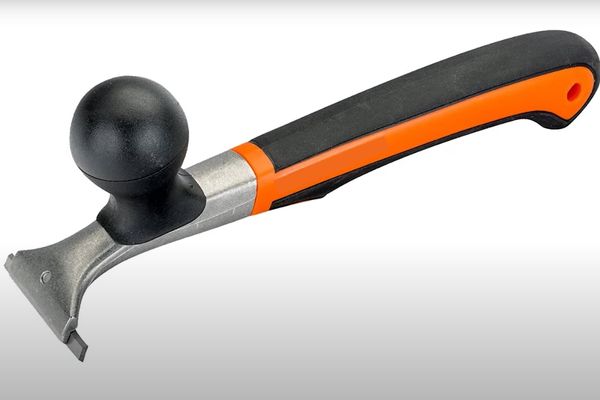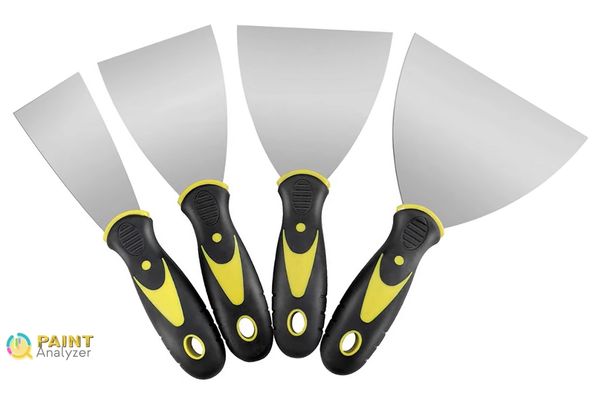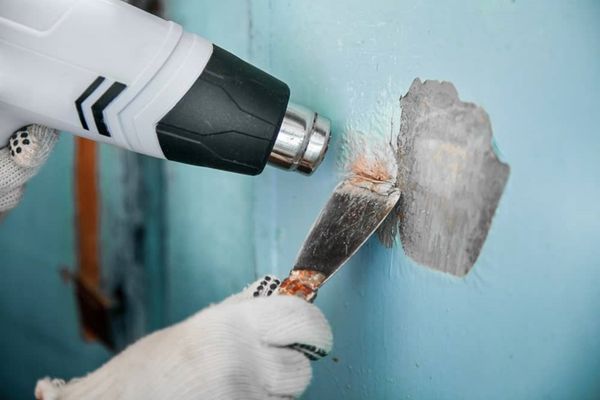When it comes to manually remove paint from walls, there are a few different types of scrapers that can be used, depending on the amount of paint that needs to be removed and the type of wall surface. For large areas of paint removal, an electric paint stripper may be the best option. But for small areas or for areas where you need to be more careful, a manual paint scraper is the way to go.
There are different types that are available on the market, each with its own unique set of features and benefits. Some of the popular manual paint scrapers are handheld scrapers, pole scrapers, putty knife scrapers, and razor blade scrapers.

What Are The Types Of Manual Paint Scrapers?
There are a few types of manual paint scrapers, and these scarpers are favorites for the prep work of any paint job. Some of the types are discussed here:
Paint Stripper
The paint stripper which is basically a stiff-bladed scraper, is best for heavy-duty jobs, such as removing paint from rough, textured surfaces. Its thick, stiff blade can stand up to the toughest scraping jobs.
Razor Scraper
Razor scrapers are versatile tools that can be used for a variety of tasks, including scraping paint. While they are typically used to remove paint from windows, they can also be used to manually scrape paint from other surfaces.
Putty Knife
The putty knife is the most versatile among all scrapers. Its thin, flexible blade is perfect for removing paint from delicate surfaces and getting into tight corners. Putty knives are basic, all-purpose scrapers having a variety of uses beyond scraping paint. It makes them a versatile tool for any home improvement project.
No matter which type of scraper you choose, always be sure to use caution and follow the manufacturer’s instructions to avoid any accidents.
How Many Types of Blade Scrapers Are There?
There are three main types of blade scrapers in the market, and each of them has unique abilities and features.

Flat Blade Scraper
The most common type of manual paint scraper is the flat blade scraper. This type of scraper has a wide, flat blade that is ideal for removing large areas of paint quickly. However, the flat blade can also damage surfaces if not used carefully.
Curved Blade Scraper
Another type of manual paint scraper is the curved blade scraper. This type of scraper has a curved blade that helps to prevent damage to surfaces while still being able to remove large amounts of paint quickly. The only downside to using a curved blade scraper is that it can be more difficult to control than a flat blade scraper.
Pointed Blade Scraper
The last type of manual paint scraper is the pointed blade scraper. This type of scraper has a sharp, pointed blade that is perfect for getting into tight spaces and removing small amounts of paint without damaging the surface beneath. However, like the other two types of scrapers, if not used carefully, the pointed blades can also damage surfaces.
Why Is It Better to Use A Manual Paint Scraper for Walls?
If you’re considering repainting your home or office, you’ll need to remove the old paint first. A manual paint scraper is a tool that can help you do this quickly and efficiently.
Cheaper
If you’re looking for a low-cost paint scraper, a manual model is a great option. These scrapers are typically less expensive than their electric or pneumatic counterparts, making them a great choice for budget-conscious consumers.
Maneuverable
Manual paint scrapers offer more maneuverability than their electric counterparts, making them ideal for getting into tight spaces and corners. Their small size and light weight also make them easier to handle, making them a good choice for smaller projects.
Safe
They are less likely to damage the surface underneath the paint, and they provide greater control over the scraping process. This makes them ideal for use in situations where a powered scraper might cause damage to the underlying surface.
What Are The Features of Good Manual Paint Scrapers?
When choosing a manual paint scraper, it is important to consider some key features to ensure that you are getting a tool that will work well and last long. With a good scraper, you can easily remove paint from any surface, making your painting projects easier.

Quality
The blade should be made of a high-quality material that is durable and will not rust. That will ensure the long life of the scraper.
Sharpness
Using a sharp scraper will help you to remove the paints quickly. So the blade of the scraper should be sharp and able to easily remove paint from surfaces.
Comfort
The handle should be comfortable to grip and use and should be able to be adjusted to fit your hand size.
Weight
The scraper should be lightweight and easy to maneuver which will help you to reach the surface where the prep work for the
How to Use a Paint Scraper
One of the most versatile tools in a painter’s toolkit is the hand-paint scraper. This simple, handheld tool can be used for all sorts of painting and finishing tasks, from removing paint and varnish to applying putty or caulk.
Hold
To use a hand paint scraper, start by holding it in your dominant hand with the blade pointing away from you.
Pressure
Apply pressure to the handle to engage the blade, then scrape it along the surface you’re working on. For best results, try to keep the blade at a consistent angle and apply even pressure as you move it back and forth.
Clean
When you’re finished scraping, disengage the blade and clean off any residue that’s accumulated on it. Wipe down the surface you were working on as well, then wash your hands thoroughly to remove any paint or other debris that may have gotten onto them.
What Type of Manual Paint Scraper Is Best for Cleaning Flat Paint Walls Without Ruining Them?
When looking to clean flat paint walls without ruining them, a manual paint scraper with a sharp, angled blade is the best tool for the job. This type of scraper allows for precise scraping without damaging the wall surface, making it ideal for removing any tough stains or imperfections.
Types And Uses Of Paint Scrapers
What Are The Uses of Manual Paint Scrapers?
Manual paint scrapers are very useful when considering scraping tools. Let’s discuss some of their uses.
Removing Paint
Manual scrapers are primarily used to remove paint, varnish, sealants, and other types of materials from surfaces.
Removing Dirt
They can also be used to remove stubborn dirt and grime. Manual scrapers are versatile tools that can be used on a variety of surfaces, including wood, metal, and concrete.
Smoothing Surface
Scrapers can also be used to smooth out rough surfaces or to remove excess material from a surface. In some cases, manual scrapers may be the only tool that can effectively remove material from a surface.
Saving Electricity
One of the main advantages of using a manual scraper is that it does not require electricity or any other power source. This makes them very convenient to use, especially in areas where power is not readily available.

Credit: homestratosphere
Conclusion
Manual paint scrapers for walls have various types, shapes, and uses. Brush and scraper are the most common types of manual paint scrapers. They are both used for removing paint stains, peeling paint, and textured paint. Manual paint scrapers work with the help of your hands, and electric paint scrapers work with the help of electricity.
Manual paint scrapers are used for different purposes, such as to clean walls, patch up holes and cracks, fill in nail holes, remove wallpaper, and sand down uneven surfaces. These scrapers can also be used in the bathroom, kitchen, garage, or in office.